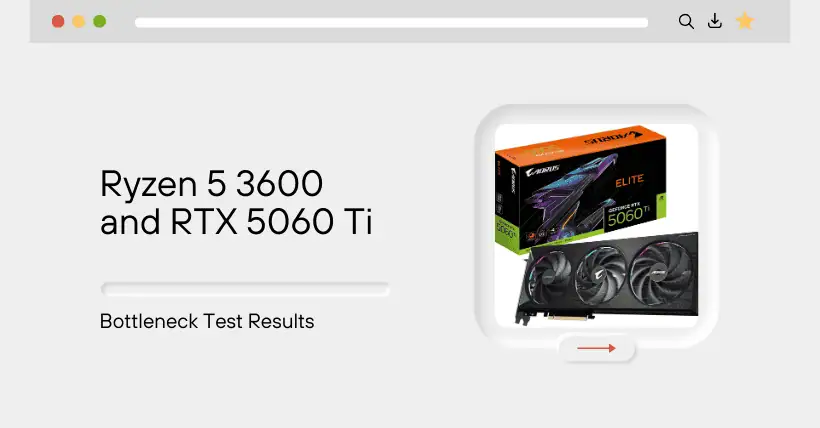1. Introduction
The Ryzen 5 3600 is a mainstream processor released by AMD in 2019. Although six years have passed, its performance is still sufficient for everyday office tasks and light to moderate gaming.
Some users still using the Ryzen 5 3600 may be considering upgrading their graphics card to improve gaming performance. This article will test the gaming performance of the Ryzen 5 3600 paired with the GeForce RTX 5060 Ti 16GB for reference.
2. Specifications Review
The GeForce RTX 5060 Ti was released on April 16, 2025, featuring the GB206-300 GPU chip, built on TSMC’s 4nm process. It includes 4,608 CUDA cores, 144 texture units, 48 raster units, 36 SMs, 144 tensor cores, 36 ray tracing units, and a 32MB L2 cache.
Its base clock is 2,407 MHz, with a boost clock of up to 2,572 MHz. It comes with either 8GB or 16GB of GDDR7 memory, running at 28 Gbps. The memory bus is 128-bit, offering a memory bandwidth of 448.0 GB/s. Its FP32 performance reaches 23.70 TFLOPS. The power consumption is 180W, with the 8GB version priced at $379 and the 16GB version at $429.
The Ryzen 5 3600 was released on July 7, 2019, using TSMC’s 7nm process. It features 6 cores and 12 threads, with a 384KB L1 cache, 3MB L2 cache, and 32MB L3 cache. The base clock is 3.6 GHz, with a boost clock up to 4.2 GHz. Its power consumption is 65W, and the suggested retail price was $199.
3. Test Platform Configuration
The main configuration is as follows:
Processor: Ryzen 5 3600
Motherboard: ASUS TUF GAMING B550 PLUS
Memory: 16GB DDR4-3600
Graphics Card: GeForce RTX 5060 Ti 16GB
SSD: ADATA Legend 960 2TB
Operating System: Windows 10
4. Game Testing (Ryzen 5 3600 and RTX 5060 Ti)
The following tests cover seven games, all run at 1080P quality settings.
Game 1: God of War
Average FPS: 66
Minimum FPS: 51
Frame Time: 11.5ms
CPU Usage: 30%
CPU Power: 47W
CPU Temp: 61°C
Memory Usage: 9.7GB
GPU Usage: 95%
VRAM Usage: 6.7GB
GPU Power: 141W
GPU Temp: 59°C
CPU usage is around 30%, running effortlessly. Memory usage is between 9GB and 10GB. GPU is slightly underutilized; VRAM usage is between 6GB and 7GB.
Average FPS exceeds 60, minimum FPS is around 50, frame time is ~11ms—no performance bottlenecks.
Game 2: Cyberpunk 2077
Average FPS: 85
Minimum FPS: 58
Frame Time: 12.1ms
CPU Usage: 83%
CPU Power: 58W
CPU Temp: 60°C
Memory Usage: 9.7GB
GPU Usage: 82%
VRAM Usage: 6.5GB
GPU Power: 129W
GPU Temp: 56°C
CPU usage exceeds 80%, under heavy load. Memory usage is between 9GB and 10GB. GPU is around 80% utilized; VRAM usage is between 6GB and 7GB.
Average FPS exceeds 80, minimum FPS above 50, frame time around 12ms—smooth performance.
Game 3: Alan Wake 2
Average FPS: 53
Minimum FPS: 45
Frame Time: 18.8ms
CPU Usage: 27%
CPU Power: 42W
CPU Temp: 54°C
Memory Usage: 8.9GB
GPU Usage: 97%
VRAM Usage: 8.5GB
GPU Power: 153W
GPU Temp: 59°C
CPU usage is around 30%, very relaxed. Memory usage is around 9GB. GPU is nearly maxed out; VRAM usage is between 8GB and 9GB.
Average FPS exceeds 50, minimum FPS above 40, frame time ~18ms—runs smoothly.
Game 4: Assassin’s Creed Shadows
Average FPS: 65
Minimum FPS: 50
Frame Time: 14.9ms
CPU Usage: 57%
CPU Power: 54W
CPU Temp: 61°C
Memory Usage: 11.6GB
GPU Usage: 97%
VRAM Usage: 5.5GB
GPU Power: 114W
GPU Temp: 54°C
CPU usage around 60%, moderate load. Memory usage is between 11GB and 12GB. GPU nearly maxed out; VRAM usage is between 5GB and 6GB.
Average FPS exceeds 60, minimum FPS around 50, frame time ~14ms—performance is solid.
Game 5: Silent Hill 2
Average FPS: 76
Minimum FPS: 58
Frame Time: 11.6ms
CPU Usage: 33%
CPU Power: 46W
CPU Temp: 56°C
Memory Usage: 9.4GB
GPU Usage: 97%
VRAM Usage: 6.3GB
GPU Power: 145W
GPU Temp: 60°C
CPU usage is around 30%, runs easily. Memory usage slightly over 9GB. GPU nearly fully utilized; VRAM just over 6GB.
Average FPS exceeds 70, minimum FPS above 50, frame time ~11ms—good performance.
Game 6: Black Myth: Wukong
Average FPS: 55
Minimum FPS: 37
Frame Time: 18.6ms
CPU Usage: 42%
CPU Power: 50W
CPU Temp: 60°C
Memory Usage: 12.9GB
GPU Usage: 98%
VRAM Usage: 7.7GB
GPU Power: 144W
GPU Temp: 58°C
CPU usage around 40%, fairly relaxed. Memory usage around 13GB. GPU nearly maxed out; VRAM usage between 7GB and 8GB.
Average FPS exceeds 50, minimum FPS above 30, frame time ~18ms—smooth gameplay overall.
Game 7: The Last of Us Part II
Average FPS: 94
Minimum FPS: 72
Frame Time: 10.5ms
CPU Usage: 94%
CPU Power: 64W
CPU Temp: 64°C
Memory Usage: 12.4GB
GPU Usage: 97%
VRAM Usage: 7.8GB
GPU Power: 139W
GPU Temp: 59°C
CPU usage is around 95%, nearly full load. Memory usage just above 12GB. GPU nearly maxed out; VRAM usage between 7GB and 8GB.
Average FPS exceeds 90, minimum FPS around 70, frame time ~10ms—overall excellent performance despite high CPU load.
5. Test Conclusion
Overall, the Ryzen 5 3600 + GeForce RTX 5060 Ti 16GB configuration does not present any performance bottlenecks. In most scenarios, the GeForce RTX 5060 Ti 16GB performs to its full potential. Only in a few demanding AAA titles does the Ryzen 5 3600 show high load and strain, but not to the extent of causing a performance bottleneck.
In other words, for those still using the Ryzen 5 3600, upgrading the graphics card to the RTX 5060 series is a viable option—there’s no need to hesitate.

Disclaimer: This article is created by the original author. The content of the article represents their personal opinions. Our reposting is only for sharing and discussion purposes and does not imply our endorsement or agreement. If you have any objections, please get in touch with us through the provided channels.



